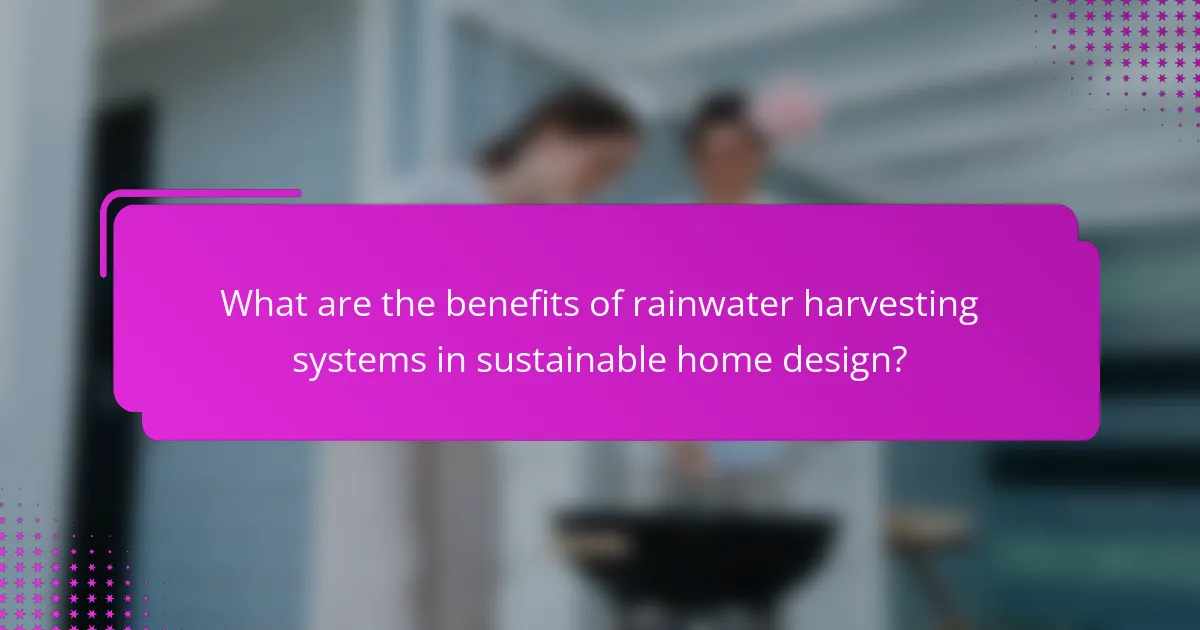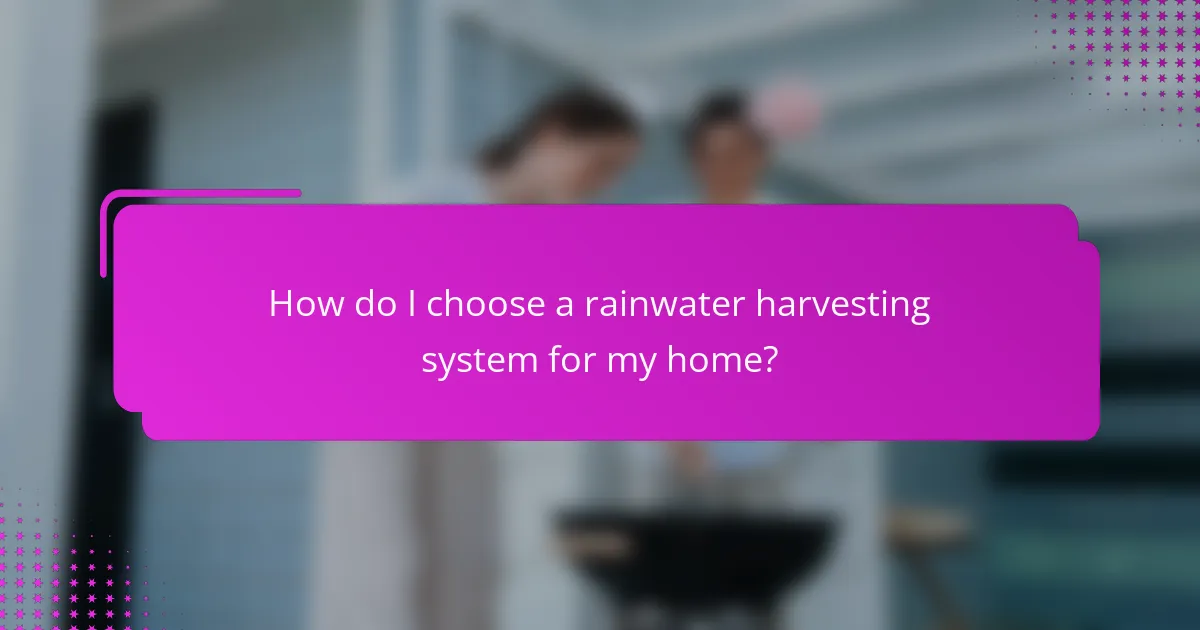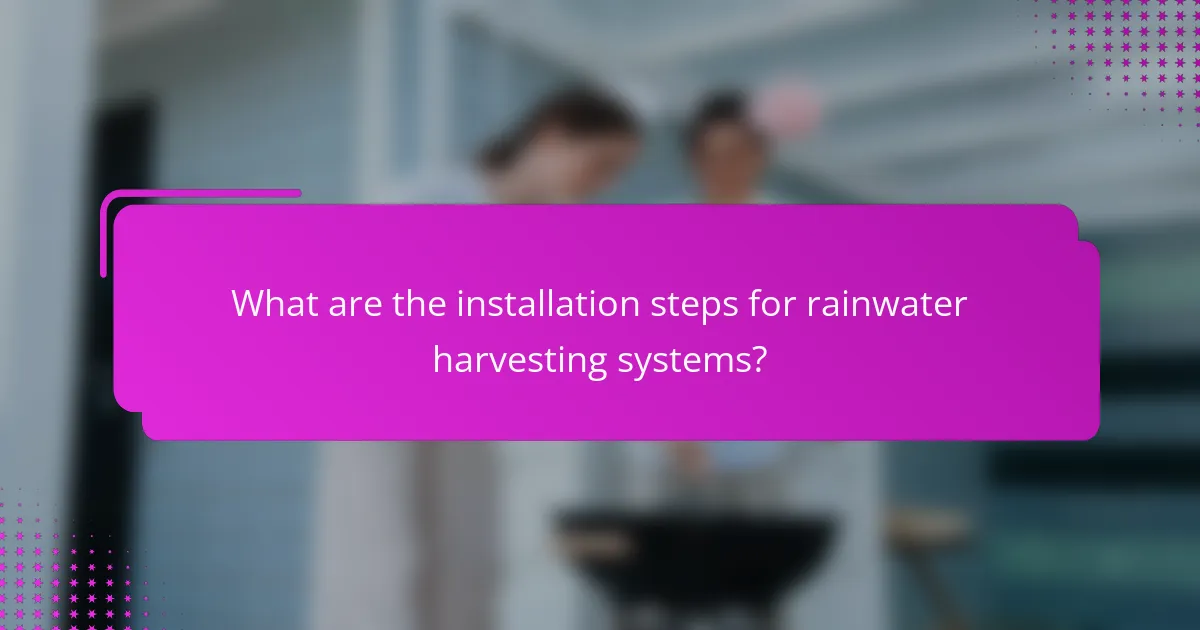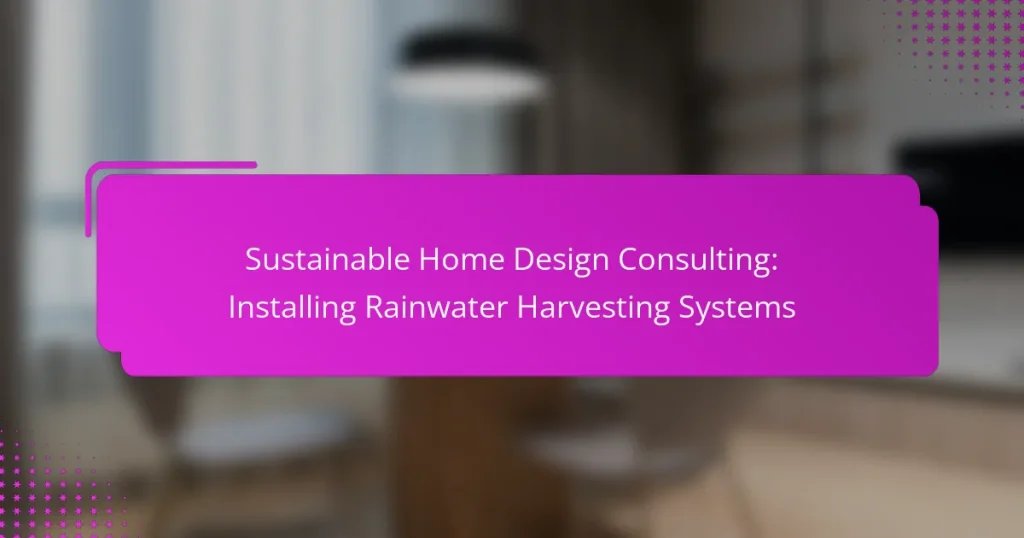Installing a rainwater harvesting system is a vital step towards sustainable home design, promoting efficient water usage and reducing dependence on municipal supplies. By carefully assessing your water needs and local regulations, you can choose a system that not only saves costs but also benefits the environment. The installation process involves a thorough site assessment and thoughtful design to ensure optimal performance and compliance with local guidelines.

What are the benefits of rainwater harvesting systems in sustainable home design?
Rainwater harvesting systems offer numerous advantages in sustainable home design, including efficient water usage, cost savings, and positive environmental impacts. By collecting and utilizing rainwater, homeowners can significantly reduce their reliance on municipal water supplies and enhance their property’s sustainability.
Water conservation
Implementing a rainwater harvesting system can lead to substantial water conservation. By capturing rainwater from roofs and directing it to storage tanks, homeowners can utilize this resource for irrigation, toilet flushing, and other non-potable uses. This practice can reduce overall water consumption by a significant percentage, especially in areas prone to drought.
To maximize water conservation, consider installing a filtration system to ensure the collected rainwater is clean and safe for various applications. Regular maintenance of the system is essential to prevent contamination and ensure optimal performance.
Cost savings
Rainwater harvesting systems can lead to considerable cost savings on water bills. By reducing dependence on municipal water, homeowners can lower their monthly expenses, particularly in regions where water rates are high. Initial installation costs can vary, but many systems pay for themselves within a few years through these savings.
Additionally, some regions offer tax incentives or rebates for installing rainwater harvesting systems, further enhancing the financial benefits. Research local regulations to identify potential savings opportunities.
Environmental impact
Utilizing rainwater harvesting systems contributes to a positive environmental impact by reducing stormwater runoff and decreasing the demand on local water supplies. This practice helps mitigate flooding and erosion, promoting healthier ecosystems. Moreover, using harvested rainwater reduces the energy required for water treatment and distribution.
By integrating rainwater systems into home design, homeowners can actively participate in sustainable practices that benefit both their immediate environment and the broader community.
Increased property value
Installing a rainwater harvesting system can enhance a property’s value by showcasing a commitment to sustainability and resource efficiency. Many homebuyers are increasingly interested in eco-friendly features, making properties with such systems more attractive in the real estate market.
Furthermore, homes equipped with rainwater harvesting systems may qualify for green building certifications, which can further elevate their market appeal and potentially lead to higher resale prices.

How do I choose a rainwater harvesting system for my home?
Choosing a rainwater harvesting system involves assessing your water needs, available space, and local regulations. Consider factors such as system size, filtration options, and any incentives that may apply in your area.
System size and capacity
The size and capacity of your rainwater harvesting system should align with your household’s water usage and the average rainfall in your region. For most homes, systems can range from a few hundred to several thousand liters, depending on the roof area and local climate.
To determine the appropriate size, calculate your daily water consumption and consider how much rainwater you can realistically collect. A common guideline is to have a storage capacity that can hold at least one month’s worth of water usage.
Filtration and treatment options
Effective filtration and treatment are crucial for ensuring the harvested rainwater is safe for use. Basic systems typically include first-flush diverters to remove initial contaminants, while more advanced setups may feature multi-stage filtration and UV treatment.
When selecting filtration options, consider your intended use for the water. For irrigation, simpler filtration may suffice, but for indoor use, more comprehensive treatment systems are recommended to meet health standards.
Local regulations and incentives
Before installing a rainwater harvesting system, check local regulations that may dictate system design, installation, and usage. Some areas may require permits or adherence to specific guidelines to ensure safety and environmental compliance.
Additionally, many regions offer incentives such as tax credits, rebates, or grants to encourage rainwater harvesting. Research available programs in your area to help offset installation costs and make your system more affordable.

What are the installation steps for rainwater harvesting systems?
The installation of rainwater harvesting systems involves several key steps, including site assessment, system design, and the actual installation process. Each step is crucial to ensure the system operates efficiently and meets local regulations.
Site assessment
The first step in installing a rainwater harvesting system is conducting a thorough site assessment. This involves evaluating the roof area, drainage patterns, and local rainfall data to determine the potential for rainwater collection.
Consider factors such as the type of roofing material, as some materials may leach harmful substances into the water. Additionally, check for any local regulations regarding rainwater harvesting, as these can vary significantly by region.
System design
Once the site assessment is complete, the next step is to design the rainwater harvesting system. This includes selecting the appropriate components such as gutters, downspouts, storage tanks, and filtration systems.
Design considerations should include the expected volume of rainwater to be collected, the intended use of the harvested water, and the space available for installation. It’s essential to create a design that maximizes efficiency while adhering to local building codes.
Installation process
The installation process begins with the setup of gutters and downspouts to direct rainwater into the storage tank. Ensure that all components are securely attached and that there are no leaks.
Next, install the filtration system to remove debris and contaminants from the collected rainwater. Finally, connect the storage tank to the distribution system for the intended use, whether for irrigation, flushing toilets, or other non-potable applications.
After installation, conduct a thorough inspection to ensure everything is functioning correctly and complies with local regulations. Regular maintenance is also essential to keep the system operating efficiently.

What are the costs associated with installing rainwater harvesting systems?
The costs of installing rainwater harvesting systems can vary significantly based on system size, complexity, and local regulations. Generally, homeowners should anticipate both initial installation costs and ongoing maintenance expenses, along with potential savings on water bills over time.
Initial installation costs
Initial installation costs for rainwater harvesting systems typically range from a few hundred to several thousand dollars, depending on the system’s capacity and components. Basic systems may include a rain barrel for under $200, while more complex setups with tanks, pumps, and filtration can exceed $5,000.
Factors influencing installation costs include the size of the roof catchment area, the type of storage tank, and any necessary plumbing modifications. It’s advisable to obtain multiple quotes from local contractors to ensure competitive pricing.
Maintenance costs
Maintenance costs for rainwater harvesting systems are generally low but should not be overlooked. Regular maintenance may include cleaning filters, inspecting the system for leaks, and ensuring that the storage tank remains free of debris. Homeowners can expect to spend around $100 to $300 annually on maintenance.
It’s essential to follow manufacturer guidelines for maintenance to prolong the system’s lifespan and ensure water quality. Neglecting maintenance can lead to higher repair costs and reduced efficiency.
Potential savings over time
Installing a rainwater harvesting system can lead to significant savings on water bills, especially in areas with high water rates. Homeowners may save anywhere from 20% to 50% on their water costs, depending on their usage and the system’s efficiency.
Additionally, some regions offer rebates or tax incentives for installing rainwater harvesting systems, which can offset initial costs. Research local programs to maximize financial benefits and enhance the return on investment for your system.

What local regulations should I consider for rainwater harvesting in California?
In California, rainwater harvesting is subject to specific regulations that ensure safety and sustainability. Key considerations include compliance with local building codes, health department guidelines, and potential permitting requirements.
Permitting requirements
Before installing a rainwater harvesting system in California, you may need to obtain a permit from your local jurisdiction. This process typically involves submitting plans that detail the system’s design, capacity, and intended use.
Permitting requirements can vary significantly by city or county. For example, some areas may require inspections during installation, while others might mandate specific filtration and treatment standards to ensure water quality.
To streamline the permitting process, check with your local building department early in your planning. They can provide guidance on necessary documentation and any fees associated with the permit application.


